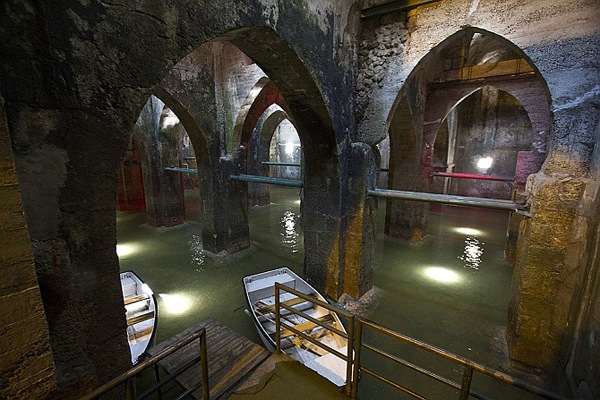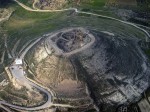An aerial view of the acropolis of Herodium. (photo from commons.wikimedia.org)
In Israel, water scarcity has long been an issue. Even the Old Testament narrates that the Hebrews complained to Moses about the lack of fresh drinking water (Exodus 17:1-7, Numbers 20:2-13) in the arid Zin Wilderness.
Whether the answer to that particular water problem came from Divine intervention or from human ingenuity or both, the fact remains that the people who populated the ancient Land of Israel figured out sustainable solutions to their water shortages. This article focuses on three historical examples of sustainable water practice.
The first of the sustainable water system to be examined takes you forward in ancient history and north of the Zin Wilderness or Desert (Midbar Tzin, in Hebrew) to Herodium, a hilltop palace and fortress built by King Herod that stood securely at the highest peak in the Judean Desert.
Herodium was constructed more than 2,000 years ago in 23-20 BCE. Needless to say, it was crucial to have access to drinking water in this semi-arid and elevated location, and four vast underground cisterns for rainwater and spring water were carved deep into the mountain. Three of the cisterns were built in close proximity, about 80 feet below the summit. The fourth was hewn slightly above, about 16 feet from the summit. The largest cistern could hold up to 400,000 gallons of water. Access to the three lower cisterns was via the northeast side of the mountain, close to Herodium’s only flight of steps.
Water traveled a few miles from the Spring of Artas to drain into the large pool of Lower Herodium. It was carried uphill on donkeys and emptied into the lower cisterns. There were two ways to obtain water from these cisterns. One, exiting the palace-fortress with empty water skins or jars via the stairs until reaching the opening to the three lower cisterns. Water would then either be carried all the way back or, two, be transported to the opening of the higher cistern, at which point water was (ingeniously) funneled into the reservoir. A bucket attached to a man-made vertical shaft then brought this water up to the palace courtyard. This method was less labor intensive and insured the privacy of the “royals.”
As the nursery rhyme states, “some like it hot and some like it cold.” At Herodium, you had both hot and cold – and more. The Roman-style bathhouse featured a below-floor heating system in both the tepidarium (warm) and the caldarium (perhaps the precursor of the hot tub?), as well as a cold bath (frigidarium), or some kind of Roman bath/Hasmonean ritual bath hybrid, according to a Stanford professor of history.
According to David Mevorah, a curator of a Herod exhibit at the Israel Museum, by installing Roman baths, the king helped spread the importance of washing to the indigenous people of ancient Israel. Moreover, at what is called Lower Herodium (apparently the high-rent district of the day), the enormous pool (referred to by local residents today as El Hammam and measuring 70×45 metres or 230 feet) functioned as a swimming pool, a water reservoir and a small lake for boating, according to historians.
Today, Herodium is no longer a hilltop palace-fortress, but an amazing national park located just south and east of Jerusalem. For directions and hours, call the Herodian National Park at 057-776-1143 or visit parks.org.il.
***
Another (though more modern) solution to water scarcity is located just across the street from the Jerusalem Theatre at 17 Marcus St. Five large cisterns once serviced the Jesus Hilfe Asyl (what later became known as the Hansen Hospital). The Herrnhut Brothers, German Christians affiliated with the Moravian Church, donated the money to build the hospital in the late 1800s. It housed and treated people who were suffering from Hansen’s disease, a bacterial disease that was misdiagnosed as leprosy.
With the water collected, the 70 hospital patients (plus, in some cases, their healthy children) and the German Sisters of Mercy met all their water requirements, including medical needs, personal sanitation, in the kitchen and laundries, and for garden and farm maintenance.
Under the supervision of Jesus Hilfe builders, local workers constructed the cisterns, the largest of which was probably built in 1898. When full, it held 15×15 metres of water. In late December 1902, it even overflowed.
The other four cisterns were fed from rain gutters, which began on the hospital roof complex. Rain was collected from the staircase, the cistern roof and even from the road outside the compound’s high stone wall. Two cisterns were built near the laundry; one cistern was built near the southern garden while the others were situated within the main building, in the central courtyard or kitchen area.
With the advent of medicines to effectively treat Hansen’s disease, the in-patient hospital closed. Over the years, it has been an Israeli Ministry of Health outpatient facility and an early-childhood development centre. At present, it is being used as a Jerusalem municipal cultural centre. Inside the facility, you can visit an informative exhibit dealing with the history of the hospital and health care in Jerusalem. For visiting hours and tour arrangements, email [email protected] or call 054-744-6123.
***
Another ingenious water system is today located in a Ramla (or Ramle) city park. During the early Muslim period, in the early eighth century, Ramla was a strategically significant town, and served as the administrative centre of Palestine. Ramla was close to the road serving the holy city of Jerusalem and the port of Jaffa. Obviously, maintaining control of such an important location meant it had to be populated. This included providing inhabitants with a viable source of water.

Entering the city park, you’ll catch a glimpse of some long, rounded structures peeking up from the ground. When you descend the steep, narrow metal staircase (that now covers the original stone) leading to the pool, you take a step back in time, into the early Muslim period. This building, however, was not just any old storage unit. This elaborate reservoir, built in 789, is decorated with heavy brick, stone arches and a domed roof. Down below, you’ll find yourself facing an underground dock. It could pass for a medieval fort or a house, except that the floor is missing. In its place, the different chambers are filled with water deep enough for row boating! Altogether, the place gives you a mini-taste of Venice, Italy, except that at Ramla’s Pool of Arches, you never see the sky.
Today, we know arches make the sturdiest of structures, but this was still a novel idea back in the eighth century. Indeed, this construction proved so successful that the 400-plus-metre Pool of Arches withstood the devastation of the 1068 CE earthquake. You can see five of the original six vaults that covered the pool. Fifteen square pillars and 16 cross-shaped pillars support the vaults. Pointed arches exist between each pair of pillars. To compliment the arches, the architect designed small windows above them. These windows were likewise shaped as pointed arches. Locals drew water from 24 square openings in the ceiling.
There are various theories about the reservoir’s original source of water. Some claim it was filled only with rainwater. A more compelling assertion is that water flowed 10 kilometres from Tel Gezer via Caliph Sulayman ibn Adb al-Malik’s water conduit (in Hebrew referred to as an amah). Two points are clear: (1) it wasn’t water from any adjacent spring and (2) we are talking about a part of the world that is hot and dry for months at a time. The engineering and maintenance of this cistern was so successful that archeologists believe it was actively used for 150 years.
The site has a somewhat obscure history and goes by a variety of names, including the Pool of St. Helena and the Pool of Al-Anziya. In the early 20th cenutry, the British repaired the pool, but it was the (post-statehood) Ramla Municipality that converted it for boating.
After you visit the Pool of Arches, make note of the continuation of the city’s old subterranean water system. Ancient water cisterns are located in the White Tower’s large courtyard.
Visitors aged 2 and up can take a boat ride; life jackets are provided. For hours and directions, call 08-977-1595, 08-920-7586 or 052-851-0715. A helpful map can be found at ramla.muni.il/eng.
Deborah Rubin Fields is an Israel-based features writer. She is also the author of Take a Peek Inside: a Child’s Guide to Radiology Exams published in English, Hebrew and Arabic (take-a-peek-inside.com).

